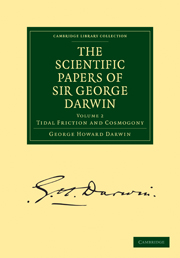Book contents
- Frontmatter
- PREFACE
- Contents
- Chronological List of Papers with References to the Volumes in which they are or probably will be contained
- Erratum in Vol. I
- TIDAL FRICTION AND COSMOGONY
- 1 On the Bodily Tides of Viscous and Semi-elastic Spheroids, and on the Ocean Tides upon a Yielding Nucleus
- 2 Note on Thomson's Theory of the Tides of an Elastic Sphere
- 3 On the Precession of a Viscous Spheroid, and on the Remote History of the Earth
- 4 Problems connected with the Tides of a Viscous Spheroid
- 5 The Determination of the Secular Effects of Tidal Friction by a Graphical Method
- 6 On the Secular Changes in the Elements of the Orbit of a Satellite revolving about a Tidally Distorted Planet
- 7 On the Analytical Expressions which give the History of a Fluid Planet of Small Viscosity, attended by a Single Satellite
- 8 On the Tidal Friction of a Planet attended by Several Satellites, and on the Evolution of the Solar System
- 9 On the Stresses caused in the Interior of the Earth by the Weight of Continents and Mountains
- INDEX
5 - The Determination of the Secular Effects of Tidal Friction by a Graphical Method
Published online by Cambridge University Press: 07 September 2010
- Frontmatter
- PREFACE
- Contents
- Chronological List of Papers with References to the Volumes in which they are or probably will be contained
- Erratum in Vol. I
- TIDAL FRICTION AND COSMOGONY
- 1 On the Bodily Tides of Viscous and Semi-elastic Spheroids, and on the Ocean Tides upon a Yielding Nucleus
- 2 Note on Thomson's Theory of the Tides of an Elastic Sphere
- 3 On the Precession of a Viscous Spheroid, and on the Remote History of the Earth
- 4 Problems connected with the Tides of a Viscous Spheroid
- 5 The Determination of the Secular Effects of Tidal Friction by a Graphical Method
- 6 On the Secular Changes in the Elements of the Orbit of a Satellite revolving about a Tidally Distorted Planet
- 7 On the Analytical Expressions which give the History of a Fluid Planet of Small Viscosity, attended by a Single Satellite
- 8 On the Tidal Friction of a Planet attended by Several Satellites, and on the Evolution of the Solar System
- 9 On the Stresses caused in the Interior of the Earth by the Weight of Continents and Mountains
- INDEX
Summary
Suppose an attractive particle or satellite of mass m to be moving in a circular orbit, with an angular velocity Ω, round a planet of mass M, and suppose the planet to be rotating about an axis perpendicular to the plane of the orbit, with an angular velocity n; suppose, also, the mass of the planet to be partially or wholly imperfectly elastic or viscous, or that there are oceans on the surface of the planet; then the attraction of the satellite must produce a relative motion in the parts of the planet, and that motion must be subject to friction, or, in other words, there must be frictional tides of some sort or other. The system must accordingly be losing energy by friction, and its configuration must change in such a way that its whole energy diminishes.
Such a system does not differ much from those of actual planets and satellites, and, therefore, the results deduced in this hypothetical case must agree pretty closely with the actual course of evolution, provided that time enough has been and will be given for such changes.
Let C be the moment of inertia of the planet about its axis of rotation;
r the distance of the satellite from the centre of the planet;
h the resultant moment of momentum of the whole system;
e the whole energy, both kinetic and potential, of the system.
- Type
- Chapter
- Information
- The Scientific Papers of Sir George DarwinTidal Friction and Cosmogony, pp. 195 - 207Publisher: Cambridge University PressPrint publication year: 2009First published in: 1908

